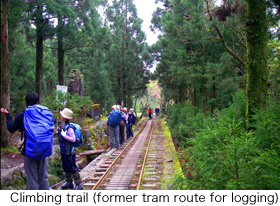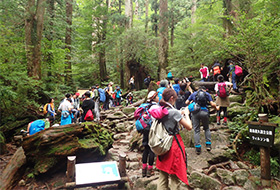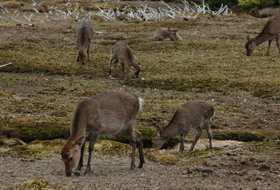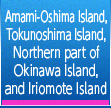- Ministry of the Environment>Nature & Parks>
- World Natural Heritage in Japan>
- Yakushima>
- Protection and management
Protection and management
In Yakushima, people have received the rich bounty from the mountains and the seas, revere nature, and have coexisted with nature without damaging it. Since prior to inscription on the World Heritage List, these sorts of local ways rooted in the lifestyle and culture unique to Yakushima have been compiled into the Yakushima Environmental Culture Village Concept, and have been shared by local residents, experts, and government agencies.
Following its inscription, the property has faced challenges like the impacts on the natural environment associated with increasing tourists and mountain climbers, as well as damage from Yaku-sika (endemic subspecies of sika deer), browsing on vegetation. Efforts to tackle these issues are being promoted in the aim of striking a balance between environmental protection and local development.
- Protected Areas in the Property
Yakushima National Park Special Protection Zone: 7,419 ha Special Zone: 2,109 ha Yakushika Wilderness Area: 1,219 ha - (Under jurisdiction of MOE)
Examples of Efforts


Promoting Appropriate Use Such as Measures concerning Mountain Climbers toward the Jomon-sugi Cedar
Since a high-speed boat connecting the Kyushu mainland with Yakushima put into commission in 1989, the number of visitors entering the island has surged rapidly, with this trend continuing on after its inscription as well. In 2000 there were about 160,000 mountain climbers. The number then peaked at about 330,000 in 2008, and has remained at about 200,000 in recent years. As the increase in the number of users has brought about problems like the erosion of mountain trails, the Ministry of the Environment and other relevant government agencies, with the cooperation of local stakeholders, are working on environmental conservation measures aimed at providing a high-quality user experience and avoiding or reducing the impact on the natural environment caused by intensive use. These measures include maintaining facilities like mountain trails and toilets, introducing portable toilets, imposing restrictions against bringing personal vehicles, and running mountain buses.
Also, the Yakushima Association for the Promotion of Ecotourism was launched. It has been promoting ecotours that give visitors a real feel for the old lifestyles and traditions that still remain in the settlements on the island, in addition to tours in the mountain areas where use is concentrated. The association is further developing an overall concept that outlines the rules and natural resources for implementing ecotourism on Yakushima.

Measures against Yaku-sika
It has been said that on Yakushima there are 20,000 people, 20,000 monkeys, and 20,000 deer, with the Yaku-sika beloved as a representative wildlife of the island. For unknown reasons, the number of deer captured from about 1967 onward had declined, and as a request from the local residents, conservation measures were started that restricted their capture in 1971. After that the deer population recovered, but this led to agricultural and forestry damage. There is also growing concern about the impact of deer on forest vegetation, due to the increasing feeding damage by deer on rare and endemic plants even in the World Heritage property and its environs.
Therefore, Yaku-sika Working Group was established under the Scientific Committee for the Yakushima World Heritage property in 2010 to promote countermeasures through the combined efforts of the relevant government agencies and experts. In FY2011, Yakushima Ecosystem Maintenance and Recovery Project Plan, and Kagoshima Prefecture Protection and Management Plan for Category 2 Specified Wildlife (Yaku-sika Deer) were developed. Based on these plans and the Yakushima World Heritage Area Management Plan, deer population control is being promoted to ensure an appropriate density for the protection and management of the World Heritage property, and to maintain and restore the ecosystem through vegetation protection and other measures.
Yakushima Mountain Worship and Mountain Pilgrimages
The traditional ritual of mountain pilgrimages to Yakushima has existed since long ago, with this having been passed down to the present. Mountains in the World Heritage property such as Mt. Miyanoura-dake, Mt. Nagata-dake, Mt. Kuriodake, Mt. Tachu-dake, and Mt. Aiko-dake are the focus of these mountain pilgrimages. People pay homage at small stone shrines erected at the summits, and pray to cast away misfortune and for peace and plentiful harvests. On Yakushima the mountains that can be seen from the villages are called maedake, or front-facing mountains, while those mountains towering in the interior that cannot be seen from the villages are called okudake, or inner mountains. A sense of reverence for okudake, where unrelenting nature unfolds and humans cannot easily approach, nurtured the mountain pilgrimage tradition.
The local residents strive to coexist with nature under these values and principles of honoring nature. This should be kept in mind as the fundamental mindset for conserving the natural environment of the Yakushima World Heritage property. In the Yakushima World Heritage Area Management Plan, conservation and management measures are based upon the values and principles of the local residents.







